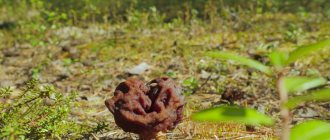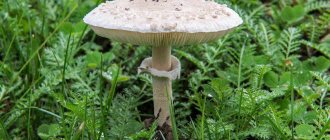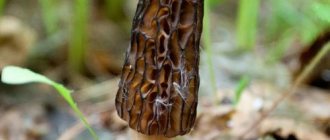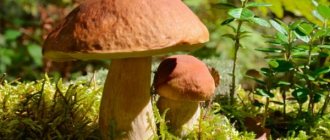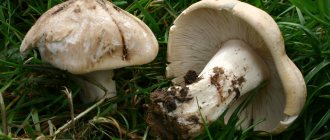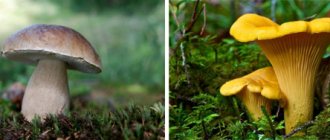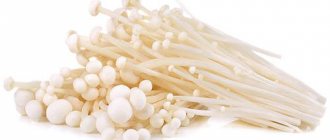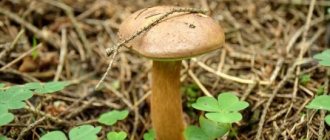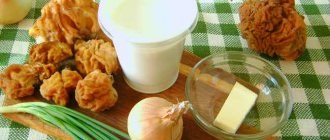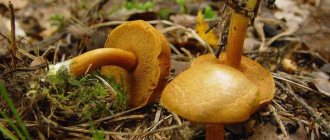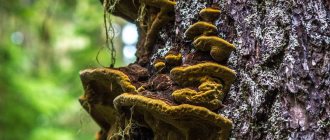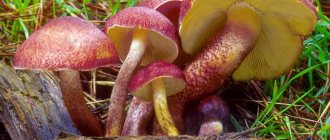These mushrooms, strictly speaking, are not even “relatives”, since botanically they belong to different families. But their fruiting bodies are so similar, and they emerge from the ground at the same spring time, when other edible mushrooms are still on the way, that many people openly confuse them. But in vain.
Why in vain? Because one of the types of these spring mushrooms is quite edible and suitable for food after minimal cooking, and the second is only conditionally edible, that is, in its raw form it is truly poisonous and requires careful and long heat treatment.
Let's understand morels and morels - where they grow, what they look like, how they differ, when to collect them, how and what to cook from them. Here are photos and descriptions of popular mushrooms.
Systematics, characteristics and description of the structure
Edible morel, or real morel (lat. Morchella esculenta) is an edible mushroom belonging to the Morel family.
In the scientific community, morel has several synonyms:
- Phallus esculentus;
- Helvella esculenta;
- Morellus esculentus;
- Morchella rotunda var. esculenta.
The fruiting body is represented by an apothecium, a special type of body that differs from other cap mushrooms.
The cap of the edible morel has a characteristic ovoid, blunt-pointed shape with a large number of folds; in young mushrooms it can be round or flattened-spherical. The color depends greatly on the growing conditions - from yellow-ocher to dark brown. The older the morel, the darker the cap. Dimensions range from 3-7 cm in height and 3-8 cm in diameter. The folds are thin (1–2 mm thick).
The hymenophore - the part of the mushroom that carries the theetium - in morels is located not inside the cap, but outside, lining its bottom and pits.
Reference. The temium is the spore-bearing layer of ascomycetes.
The stalk is hollow inside, the wall thickness is 3–4 mm, the average diameter is 1.5–3 cm. The length of the stalk ranges from 3–9 cm. In young mushrooms it is milky white or creamy white, smooth, darkens as the mushroom ages and is covered with thin flakes.
The cut flesh is the same color as the leg and does not darken. Very brittle, crumbles quickly, especially with old mushrooms. It has no distinct odor after cutting.
Ordinary stitches
The stitches are also widespread across both the Eurasian and North American continents.
Like morels, lines appear on the soil surface already in the spring, in April-May, and last until early June.
It is important to remember that there is another type of stitch, in addition to the usual one - autumn stitch, which can be found from July to September and which is definitely poisonous.
These fungi prefer light sandy soils and conifers (especially pine trees) rather than deciduous trees. The lines can be found in groups in old fires, forest clearings, and in places well warmed by the sun.
What do the lines look like? They do not grow as large in height as morels, and usually do not exceed 10-15 cm in height, although they often spread out greatly. Their stem is uneven in shape, short, often completely invisible under the “influx” of a much darker cap, hollow, but dense to the touch, often narrowed towards the base. The cap can be of different colors - from light and dark brown to shades of purple or orange. The surface of the stitching cap is also uneven, but not porous, namely “wrinkled”. If we compared the cells of a morel cap to a honeycomb, then their walls (“convolutions”) are much wider, thicker and fleshier, to some they resemble “brains”, to others the surface of a peeled walnut. The older the mushroom, the more wrinkled its cap. The inner pulp of the mushroom is light, “waxy”, brittle, with a distinct fruity odor, and has a pleasant taste.
Also classified as conditionally edible is another type of stitch that we often encounter, the giant stitch, which differs from the ordinary one in its lighter yellowish-ocher cap, large size, and also “gravitation” to birch thickets. Its pulp is thin, brittle, waxy, with a pleasant mushroom smell.
According to different types of classification in different countries, ordinary mushrooms are classified as either conditionally edible or poisonous mushrooms. For example, in Italy their collection and sale is prohibited, but in Eastern Europe and the USA the stitches are readily eaten, albeit with all precautions - there is, however, a theory that this happens historically, because These mushrooms differ in chemical composition, depending on the region of growth.
Why are they dangerous? Stitches, like many other members of their family, in their raw form contain a carcinogenic toxin that also affects the liver and autonomic nervous system, which, when ingested, causes severe nausea and vomiting, especially in children. To minimize the effect of the toxin on the body, mandatory long-term heat treatment of the stitches is used.
Since strings and morels, depending on the place of growth and age, can be very similar in appearance, it is recommended to intensively heat treat both types of mushroom before eating - boil them twice in salted boiling water for at least 15 minutes each time, followed by draining the broth and thoroughly washing in running water. Prolonged drying of these mushrooms at elevated temperatures will also help neutralize the toxin.
Dangerous false doubles
The true morel is difficult to confuse with other species, since it is very characteristically different from most poisonous species; In the Morel family, all mushrooms are considered conditionally edible.
However, an inexperienced mushroom picker should look at the difference in the photo in order to distinguish the morel from its most dangerous double - the ordinary line.
The differences between the morel and its dangerous brother can be seen in the table:
| Type of mushroom | hat | Leg |
| Edible morel | Cone-shaped, folded-cellular, hollow inside | White, long, hollow inside, brittle |
| Ordinary stitch | Flattened, similar in shape and folds to a walnut, has no cavity | Short, thick, empty, with a pink tint |
Where, in what forest and when can you pick morel mushrooms?
Morels
Morel mushrooms appear only on soils favorable for their growth, namely:
- In coniferous and mixed forest plantations and forests, on the edges, along roads, clearings
- In garden plots
- On the ground after fires
- In parks and gardens
Morels grow equally well in fertile soils as well as in sandy and sandy loam soils. Finding such a mushroom is not easy, as its cap blends in with the color of last year’s foliage and dry grass. These mushrooms are collected in April-May.
Evaluation of taste qualities, medicinal properties, benefits and possible harm
Morels are conditionally edible mushrooms that are edible after pre-processing. This type is a delicacy (although in Russia it belongs to the third category of products), has a low calorie content, and gives dishes a characteristic aroma and taste due to the high content of aromatic substances.
With regular consumption of morels, the following medicinal properties of the mushroom may appear:
- improvement of visual acuity;
- strengthening the eye muscles;
- improved digestion;
- removal of waste and toxins;
- strengthening the immune system and increasing the internal tone of the body.
In folk medicine, the edible morel is used as a remedy for diseases of the stomach and intestines, autoimmune disorders and blood diseases, as well as to restore strength after treatment of pulmonary tuberculosis.
It is not recommended to consume morels for the following categories:
- children under 12 years old;
- during pregnancy and during breastfeeding;
- for severe diseases of the cardiovascular system;
- with individual intolerance.
Eating raw or not properly processed mushrooms leads to poisoning, the symptoms of which appear within 6–10 hours.
Among the symptoms, the most dangerous is the risk of developing convulsive seizures, as well as toxic liver damage.
Useful properties and contraindications for the use of morels
Morels, as it turns out, contain quite a lot of substances that are beneficial for the body. Like other edible mushrooms, they are high in protein. It makes up almost 25% of the fruiting body. There are amino acids and B vitamins here.
The energy composition is also good: 2.9 g of protein (this is 12 kcal), 0.4 g of fat (this is 4 kcal) and 2 g of carbohydrates (this is 8 kcal). The total calorie content per 100 g of mushrooms is 24 kcal.
Thus, it turns out that morel is a very low-calorie product. Therefore, it is suitable for diets.
Among other elements, about 3% nitrogenous substances and 1% sugar were identified. They also contain various polysaccharides, aromatic substances, and vitamin C.
Beneficial properties appear to improve vision, increase appetite, and cleanse the blood. The mushroom also has a tonic effect.
Primary processing and cooking recipes
Primary processing of morels involves boiling the cut mushrooms (the lower part of the stem is removed) for 10–15 minutes in salted water, which is then drained. If in doubt or if there are a large number of mushrooms, carry out the procedure twice, then rinse under running water.
Mushrooms processed in this way are used in the preparation of various dishes.
It is allowed to dry morels in cut form for 3–4 months until completely dry. Dry morels are stored in boxes or paper bags away from moisture. A powder is prepared from dried mushrooms, which is used as a natural flavoring for ready-made dishes.
Stewed morels with sour cream sauce
Ingredients:
- 500 g morels;
- 4–5 tbsp. spoons of sour cream;
- 1 teaspoon flour;
- frying oil;
- salt, pepper to taste.
Cooking method:
- Pre-boiled morels are fried in hot oil for 15 minutes over medium heat.
- Reduce the heat to low and add flour, fry for 3-4 minutes.
- Season the mushrooms with sour cream and simmer for 5–10 minutes under the lid.
- Served with a side dish of potatoes or pasta.
Morels with potatoes
Ingredients:
- 400 g morels;
- 2–3 medium potatoes;
- 1 onion;
- vegetable oil for frying;
- spices, herbs to taste.
Cooking method:
- The onion is cut into half rings or finely chopped.
- The chopped vegetable is fried in preheated oil until golden brown.
- Add chopped, pre-boiled morels and fry for 5 minutes.
- Potatoes are cut into long strips and added to the onion-mushroom fry.
- The mixture is fried until the potatoes are soft, salt and seasonings are added to taste.
- Before serving, decorate with herbs if desired.
Growing at home
The best place for cultivating morels is an apple orchard. In addition, they grow well in prepared areas of broad-leaved forest, where there is natural shade from trees.
Principle of growing morels:
- Preparing the soil for sowing mycelium. Considering that morels do not tolerate stagnant water, a drainage system should be built on the selected plot of land and the top layer of soil should be replaced with a specially prepared substrate. The “correct” soil mixture is prepared according to the following scheme: every 6 portions of garden soil are combined with one part of ash and half the volume of wood shavings. The finished substrate is mixed and then laid out in a ten-centimeter layer on equipped beds. The laid soil is watered abundantly with water (10 liters per 1 sq. m of land).
- Inoculation of mycelium. To get a good harvest, it is better to purchase spores from trusted suppliers, rather than using overripe morels collected independently in the forest. The mushroom mycelium is distributed over the surface of the prepared substrate and then crushed with a small layer of earth (5 cm). After this, the soil is watered and covered with natural “insulation” (straw, leaves, small branches, apple pomace).
- Cultivation and harvesting. After sowing the mycelium, it is important to monitor the level of moisture in the substrate. As it dries, a special nutrient concentrate is added to the soil to promote intensive germination of spores (for example, “Baikal EM-1”). In addition, to stimulate fruiting, the beds can be sprinkled with a thin layer of ash.
Best materials of the month
- Coronaviruses: SARS-CoV-2 (COVID-19)
- Antibiotics for the prevention and treatment of COVID-19: how effective are they?
- The most common "office" diseases
- Does vodka kill coronavirus?
- How to stay alive on our roads?
The harvest is harvested 12 months after sowing. Interestingly, in one place the mycelium can bear fruit for 3 to 5 years. Caring for germinating spores comes down to timely moistening the soil and feeding the plant with wood ash. In autumn, the area is additionally covered with leaves, straw or grass. In the spring, after the snow melts, the protective cover is removed, leaving a thin layer of plant material.
In most cases, after 2-3 weeks, morels begin to bear fruit. Considering that young mushrooms have delicate flesh, it is better to use a sharp knife and a spacious container to collect them.
Remember, due to their fragility, morels quickly lose their presentation, so they should be transported as carefully as possible and in a short time.
Video gallery
Video reviews
A selection of videos with descriptions and recipes for preparing mushrooms
Sergey Zhigalov, about Mushrooms and Plants in Your Own Words, SV NoSoRoG
Can there be morel mushroom poisoning?
Morel Mushrooms
It has long been known that mushrooms absorb harmful toxins from the soil. Therefore, it is not recommended to collect any mushrooms in contaminated areas. This also applies to morels. Mild poisoning may occur if such mushrooms are not prepared correctly, since each organism perceives helvella acid differently. Therefore, before cooking, thoroughly soak the mushrooms and boil, changing the water 3 times.
Don't eat morels in large quantities. Serve them as a delicacy - tasty and original.
Morels baked in sour cream sauce
Morels baked in sour cream sauce
This is a very tender dish, somewhat reminiscent of a soufflé. Prepares very quickly, served in portioned molds.
Ingredients:
- Boiled mushrooms - 200 g;
- Sour cream - 100 g;
- Chicken eggs - 1 piece;
- Butter - 30 g;
- Cheese - 100 g;
- Salt
- Onion - 1 pc.
Preparation:
- Cut the morel into small pieces.
- Cut the onion into small cubes.
- Melt the butter in a frying pan and fry the onion in it until transparent, add the mushrooms and simmer until all the water has evaporated. Salt.
- Mix sour cream with egg, lightly salt to taste.
- Mix all the ingredients and place in portioned forms, sprinkle with grated cheese on top.
- Place in the oven and bake for 25-30 minutes at 180°C.
Serve hot.
Poisonous or beneficial
Many foreign sources classify the mushroom as poisonous. During the Soviet era, string was considered conditionally edible, acceptable for food, but requiring heat treatment.
The main health hazard is gyromitrin, which is part of it, which passes into water or decomposes within 25-30 minutes of boiling. Therefore, mushrooms are added to food carefully and only after special processing.
Collection season and distribution
In the wild, mushrooms are common in Europe, Asia, North America and Australia; they prefer coniferous and deciduous forests, but can also grow in gardens and park areas. The maximum yield is harvested in a temperate climate, on light grassy areas, light calcareous soils.
The fruiting period occurs in spring. Where the climate is milder and warmer, you can start harvesting in March; in cool regions, mushrooms grow later - from April to May. If the autumn is warm, then the crop can be harvested again - from October to November.
Pasta baked with morels
Pasta baked with morels
This is a very tasty dish that is not difficult to prepare at home, and don’t let the ingredients scare you.
The dish turns out amazing, and the taste of the morel sauce in this dish will be more refined, even than the sauce made from noble mushrooms. Try it, I'm sure you'll like it.
Ingredients:
- Tagliatelle pasta – 4 “nests”
- Boiled morels – 200 gr.
- Medium onion – 1 pc.
- Olive oil – 1/2 cup
- White wine – 4 tbsp.
- Cream 35% fat – 1 cup
- Tomato sauce – 2 tbsp.
- Soy sauce – 3 tsp.
- Sweet paprika - a pinch
- Hard cheese - 200 g.
- Salt
Preparation:
- We do not cut the mushrooms into large pieces.
- Chop the onion into half rings.
- Heat the oil in a frying pan and fry the onions and mushrooms in it for two minutes.
- Add wine and evaporate by half.
- Add tomato sauce, cream, soy sauce and paprika. Mix and set aside on the steam table, that is, the main thing is that it remains warm.
- Boil pasta in salted water according to instructions.
- Place the pasta in portioned forms, put the sauce on top and sprinkle it all with cheese.
- Bake in the oven at 180°C until the cheese melts.
Serve it piping hot)))
Habitat
The distribution area in Russia is predominantly deciduous forests, edges of mixed forest plantations, clearings, ditches, clearings. However, morels grow not only in deciduous and mixed forests. They can be found on lawns, near landfills, old fireplaces and burnt areas, in parks, grassy meadows and even sand (Figure 4).
The first myceliums grow in well-moistened forests in April, the peak of activity occurs in May-June and decline in warm October or late September.
Mushroom pickers eagerly opening the season are advised to go searching in the nearest forest. The common morel hides under trees, bushes, and in ravines on humus.
Figure 4. Morels are found everywhere, although they prefer well-lit areas
The conical morel is less “shy”, so it can be found right in the middle of a clearing sticking out through the remains of unmelted snow.
How dangerous are morels?
Morels and strings contain a dangerous toxic substance - gyromitrin. There is more of it in the lines, in morels and morel caps - in very low concentrations. Some researchers believe that in some areas morels do not contain the toxin. But doctors recommend pre-boiling or scalding morels with boiling water and draining the water. Then this very tasty mushroom will bring pleasure and will not cause harm.
At our dacha, in late April - early May, in some years, many conical morels grow under two huge apple trees. For a long time we could not explain this strange phenomenon. Later we learned that there are German and French methods for artificially breeding morels. The German method is that morels (ground saprophytes) are bred in the forest or in the garden, first sowing pieces of mushrooms and then covering them with ash. I also apply wood ash under the apple trees every year (especially in the fall). The massive appearance of morels also justifies the French method of breeding them. Its essence lies in the fact that in France, morels are grown in those places where unpicked apples have been left lying on the ground since the fall. This is our option. There are so many apples that we often cannot pick them. In the fall, I often only have time to rake them into piles, which I cover on top with half-decomposed compost. It turns out that the French specially make beds with a layer of apple pomace, which they cover with leaves for the winter. In early spring, the leaves are removed and morels are waited for to appear.
How to properly prepare mushrooms?
- It is necessary to clean the leg of sand; if the leg is very dirty, then cut off the leg.
- We inspect for the presence of slugs or snails, paying special attention to the inside of the cap.
- Fill the morels with water for an hour, stirring occasionally.
- Then use a colander to strain out the water, rinse and repeat the procedure.
- Now boil the clean mushrooms for half an hour and strain off the water.
Attention!!!! It is imperative to boil morels, and the water in which they were boiled is MANDATORY!!! drain.
Now our mushrooms are prepared and ready for further cooking.
Danger
The product contains a toxic substance - gyromitrin. The toxic properties of the toxin appear after 5-10 hours. The clinical picture includes symptoms typical of intoxication:
- nausea, ending with an attack of vomiting;
- loose stools;
- severe pain and cramps in the abdominal area;
- headache;
- yellowing of the skin;
- increased body temperature;
- the appearance of chills and general weakness;
- disturbance of consciousness.
In the absence of first aid and treatment, after consuming an improperly prepared product, dangerous complications can occur, leading to death.
The morel has deep wrinkles on the surface of the cap.
How to distinguish an edible morel from a string
In spring, mushrooms that look like morels appear in the forest. They are called lines. The main differences are:
- short wide leg;
- rounded flattened cap shape;
- deep wrinkles on the surface of the cap, making it look like a walnut kernel;
- the presence of a large number of partitions in the body.
The following signs help to distinguish an edible mushroom from its poisonous counterpart:
- cellular structure of the cap;
- high leg height;
- the presence of voids in the body of the mushroom.
The lines contain toxins that negatively affect the condition of the liver and central nervous system. Some experts believe that poisoning with these mushrooms can provoke the development of a malignant tumor.
